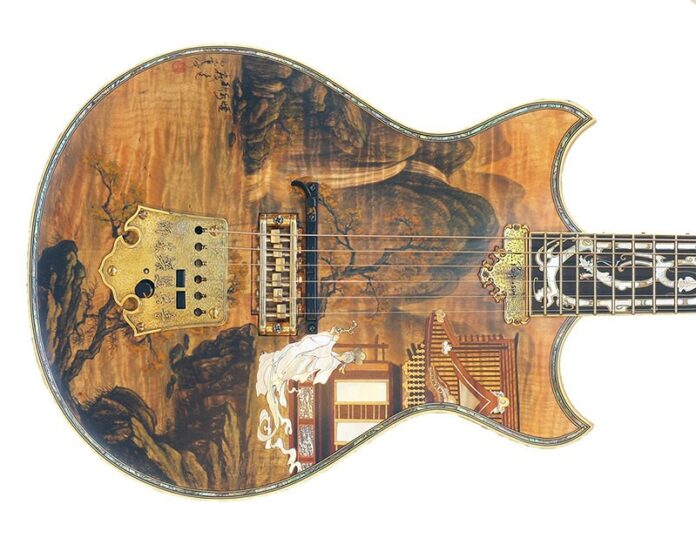A drilling mistake in 1975 changed the course of Larry Robinson’s life.
Robinson was a few weeks into a new job building guitars. “I drilled right through two basses, and my boss said, ‘Put an inlay in it and we’ll cover it up, refinish it and call it custom.'”
It was his first introduction to inlays, and Robinson was hooked. More than 40 years after this “accident,” I drive to the hinterlands of Sonoma County, eventually reaching a small, nondescript trailer. Stepping through the door of Robinson’s home studio feels like traversing the mythical looking glass: this is where the magic happens.
Art adorns the walls, musical amplifiers are everywhere and a desk is covered in tools. A fan labors to cool the air in the cramped space where Robinson works at his craft.
Inlays—artwork that is carved into the wood of guitars and other string instruments and then filled with materials such as shell, metal or plastic—require meticulous attention to detail, and planning is critical. Robinson’s art is in the details. “I try to be really precise and exact. I’m not necessarily obsessed, but I’m careful.”
“Larry has a true passion for inlay, and it shows in his work,” says David J. Marks, a woodworker and friend of Robinson who lives in Santa Rosa. “He wants to pursue techniques and visions that are the most intricate and complex that I’ve ever seen.”
Tom Ribbecke, a woodworker from Healdsburg, says, “Larry’s work is extraordinary because he always pushes the artistic envelope. He sees things in a way that I don’t—I’m so impressed constantly. Sometimes I’m so moved by what he does, I have to sit down.”
Born in Connecticut, Robinson was accepted into the Hartford Conservatory performing arts school but did not finish. He planned on becoming a classical guitar teacher, but when he hired someone to build a custom guitar for him in 1972, he was so entranced by the process that ultimately the luthier taught him how to build his own instrument.
Three years later, Robinson set out for California to visit a friend, landing in San Francisco, where he was hired at Alembic to build guitars for the likes of Fleetwood Mac and Led Zeppelin under Rick Turner. (Rick Turner Guitars is now in Santa Cruz.) It was here that the fateful accidental drilling took place.
When Turner left to start his own company, Robinson went his own way. He worked at Modulus Graphite, a bass guitar company in San Francisco, but soon grew tired of the commute. In 1984, Robinson left his job, determined to fully support himself in Sonoma County through his own inlay creations.
He quickly made a name for himself. “I had a lot of people asking me to be an apprentice,” Robinson says, “but I’m just not that focused on teaching people with that method.” In 1994, he published The Art of Inlay. Now in its third edition, the book is “basically a how-to,” Robinson says, “an instruction manual that has all the eye-candy you could want.”
In May, Robinson released his second book, The Invisible Line: When Craft Becomes Art. Featuring seven artists involved in the creation of custom instruments—including himself, Marks and Ribbecke—the book explores definitions of art and craft. In the book, Robinson reflects on the emotions invoked by his work at a guitar show where one of his creations, dubbed “Meet the Beetles” (an acrylic instrument with real beetles layered inside it), triggered strong reactions. “Some people hated [it] and some loved it. Few were neutral . . .”
Compared to The Art of Inlay, Robinson says The Invisible Line is “more philosophical. There are few instances where people will tell you how they did something. It’s more about an attitude.” He adds, “[Art] permeates every little aspect of our lives. I wanted to give people a look from our perspective.”
Marks agrees. “It’s a lifestyle. We’re eating, breathing and living this stuff all day long, every day. Your life is revolving around what you love to do.”
Robinson recognizes that any definition of art is entirely subjective. “If anything has been solved by this book, it’s that nobody can tell you what [art] is and what it isn’t.” Ribbecke adds. “We’re not fixing people’s hearts, we’re not solving war and peace in the Middle East. We’re scratching a creative itch and making the planet a little bit of a better place.”
When asked about the legacy he hopes to leave behind, Robinson quotes Frank Zappa: “I don’t care, I’m going to be dead.” But his dedication to each guitar contradicts that sentiment.
“If this is the last inlay that I ever do, my life will be judged upon it. My quality remains consistent.” He says he’s “trying to make the world more beautiful—and trying not to step on too many toes along the way.”
But Robinson isn’t finished yet. “Every time I try to get out of this business—and I have, on occasion—somebody comes along and gives me a nice job to get back into it again.”











